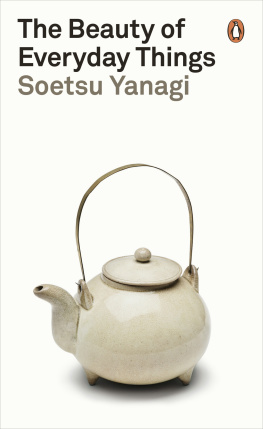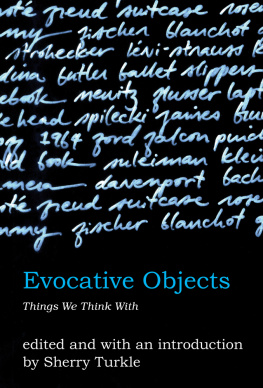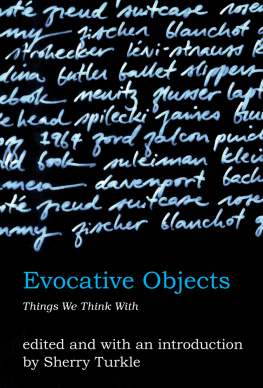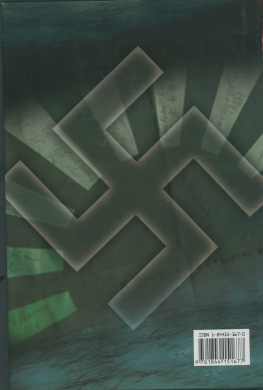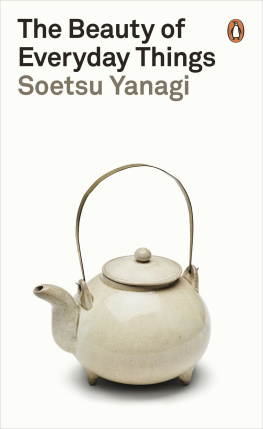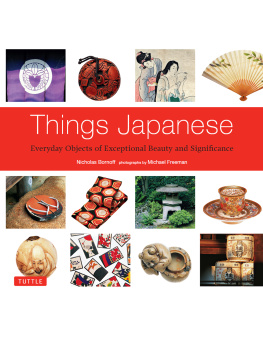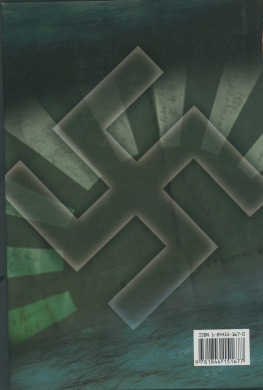PENGUIN CLASSICS
THE BEAUTY OF EVERYDAY THINGS
Soetsu Yanagi (18891961) was a philosopher, art historian, aesthete and poet. He evolved a theory of why certain objects made by unknown craftsmen were so beautiful, and became the founding father of the Japanese folk crafts (mingei) movement. He helped establish, and was the first director of, the Japan Folk Crafts Museum.
Soetsu Yanagi
THE BEAUTY OF EVERYDAY THINGS
Translated by Michael Brase

Note to the Reader: Japanese names are given in Japanese order (surname first) for persons active before the Meiji Restoration of 1868, and in Western order (surname last) for persons active thereafter. Macrons are not utilized.
PENGUIN CLASSICS
UK | USA | Canada | Ireland | Australia
India | New Zealand | South Africa
Penguin Books is part of the Penguin Random House group of companies whose addresses can be found at global.penguinrandomhouse.com.
First published in Japan as Soetsu Yanagi: Selected Essays on Japanese Folk Crafts by the Japan Publishing Industry Foundation for Culture (JPIC) 2017
This edition published in Penguin Classics 2018
The essays appearing in this book were selected from Yanagi Soetsu korekushon 2: mono (Chikiuma Shobo; )
Translation copyright Japan Publishing Industry Foundation for Culture, 2017
Photographs copyright The Japan Folk Crafts Museum

The moral right of the translator has been asserted
Cover design by Jim Stoddart; Sake Pot
Courtesy of Mingei International Museum
ISBN: 978-0-241-36636-3

WHAT IS FOLK CRAFT?
1933
I. The Origin of the Word Mingei
The Japanese word for folk craft or folk art, mingei, is actually new to the language. Being new, it is often confused with tribal art, peasant art, or even the more inclusive arts of the common people. In coining this word, however, Shoji Hamada, Kanjiro Kawai, and I had something simpler and more direct in mind. We took the word min, meaning the masses or the people, and the word gei, meaning craft, and combined them to create mingei. Literally, the word means crafts of the people. It is meant to stand in contrast to aristocratic fine arts, and refers to objects used by ordinary people in their daily lives. These objects include household effects such as clothing, furniture, eating utensils, and stationery. In common parlance they are referred to as ordinary things (getemono), the roughly made (sobutsu), and sundry implements (zatsugu). All of these are counted as mingei or folk craft.
Folk craft objects in this sense have two principal features. One is that they are things made for daily use. Second is that they are common, ordinary things. Conversely, they are neither expensive nor produced in small numbers. Their creators are not famous artists but anonymous artisans. They are not made for viewing pleasure but for daily use. In other words, they are objects indispensable to the daily life of ordinary people, that are used in commonplace settings, that are produced in large numbers, and that are inexpensive. Thus, among the various types of handicrafts, broadly speaking, folk crafts are those crafts that are deeply embedded in the life of ordinary people.
However, when coining the word mingei, in addition to this broad meaning we also wanted to define the term more narrowly. If we simply defined mingei as referring to practical objects used by ordinary people, all kinds of cheap things commonly displayed in stores would fit that criterion. Among mingei objects we wanted to include only those with certain specific characteristics. One essential feature should be that the objects honestly fulfil the practical purpose for which they were made. In contrast, look at the machine-made objects that inundate our lives in recent years, which have fallen victim to commercialism and the profit motive, usefulness shunted aside. Among these objects ostensibly made for practical use, there are many that are nothing more than frauds and fakes, displaying no attempt at honest usability. On the other hand, there are the many purportedly refined objects that aim at elegance but succumb to bad taste, overburdened with needless decoration and meaningless frivolity. With these works utility becomes a secondary consideration, verging on the enfeebled and morally corrupt. In objects of daily use these are precisely the characteristics that should be avoided, for they have turned their backs on the life they should be serving.
Thus in order to be called mingei an object must be wholesomely and honestly made for practical use. This calls for the careful selection of material, the employment of methods that are in keeping with the work to be done, and attention to detail. It is only this that produces bona fide objects that will be of practical use in life. Looking at recent works, however, what one sees is an emphasis on visual appreciation over utility and the cutting of corners in the production process, resulting in objects that can only be called feeble and ugly. The fact that the colouring is vulgar, the shapes thin, weak, and prone to break, and that the finish easily flakes, all this comes from a lack of honest attention to the objects utilitarian purpose. I am tempted to call this type of work amoral and unethical.
Folk craft is thus devoted to healthy utilitarian purposes. It is, in fact, our most trustworthy and reliable companion throughout our daily lives. Essentially, it is easy to use and ready at hand, always reliable once we have become familiar with it, provides a sense of ease and comfort, and the more we use it, the more intimately it becomes a part of our lives. Folk art may be rough in nature, but it should not be slipshod. It may be cheap, but it should also be sturdy. What must be avoided at all costs is dishonest, distorted, and ornate work. What must be sought is the natural, direct, simple, sturdy, and safe. In a word, folk art must be sincere, sincerely produced for use by the common person. It is the aesthetic result of wholeheartedly fulfilling utilitarian needs. Its beauty can be called wholesome or natural.
II. The Need for Folk Craft
The majority of crafted objects are made for common use in our everyday lives. If we want this overwhelmingly predominant ordinary craftware, vis--vis fine-art craft, to flourish in the years ahead, we must ensure that, as a whole, it evolves in quality. An analogous situation can be seen in society at large: if society contains a few outstanding individuals but the mass of people is mediocre, society as a whole will not prosper. In the world of handicrafts, until just recently it was thought that anything would suffice for common ware, since it was merely for day-to-day use, nothing more. If this were true that anything will do no matter how badly made we could never achieve the idyllic Kingdom of Beauty where all crafted objects are beautiful. If only a few select fine-art objects are beautiful, this ideal world will never be realized. Similarly, if only a few priests are faithful to their religious beliefs, the world of religion can no longer be said to exist. For the kingdom of God to appear on earth, it is necessary for faith to be widely spread among the people. Likewise, it is my belief that for an idyllic age of craftware to appear among us, it is essential that ordinary crafted objects be saved from demise. Folk objects are the acme of all crafted ware. Their decline means the decline of all handicrafts. Without a healthy folk art tradition, craftware in general will lose its way. Needless to say, regardless of the country, eras in which ordinary objects were things of beauty were eras in which craftware as a whole blossomed. Among the finest works of the past, it is pellucidly clear that the most splendid of all were the folk handicrafts.

